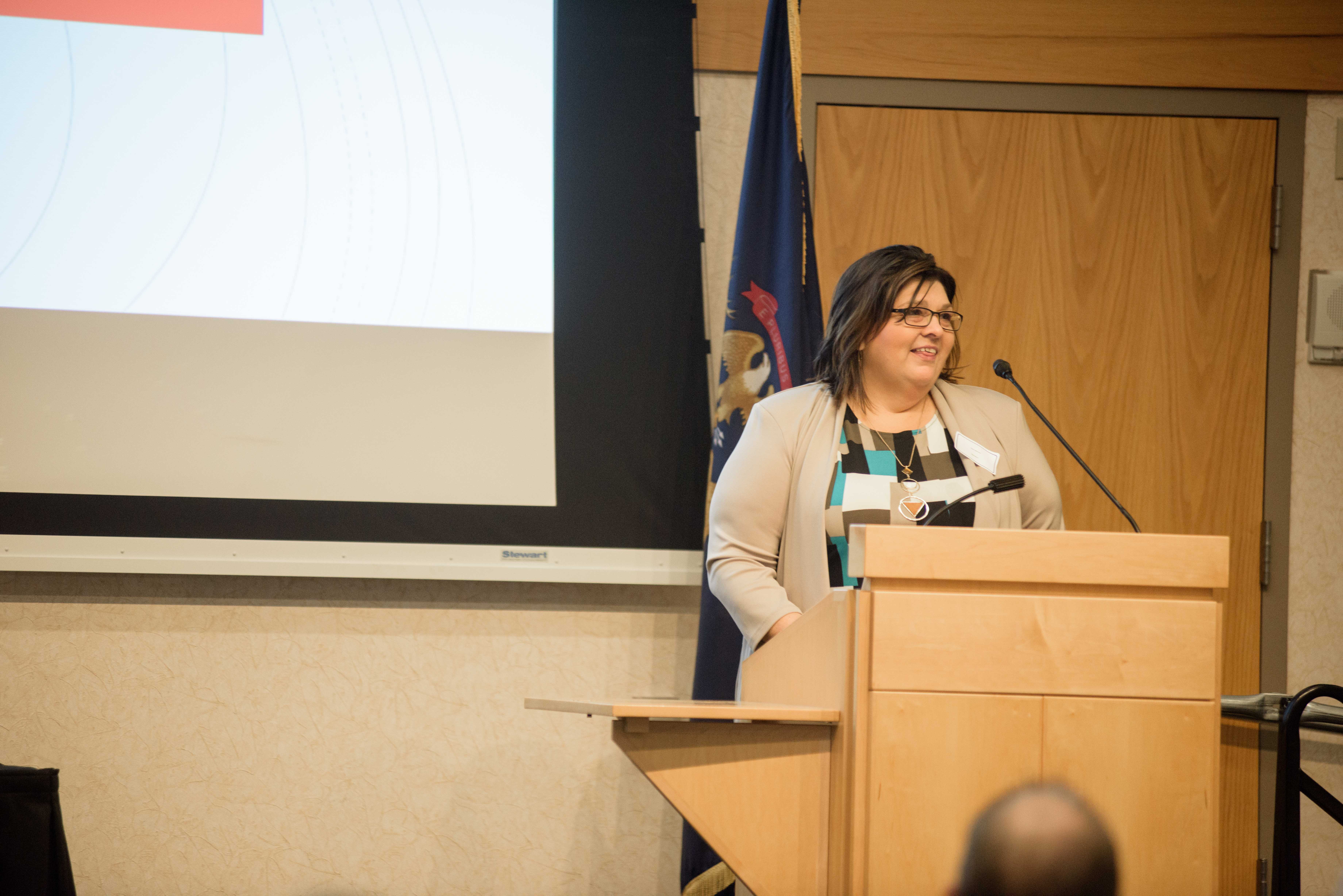
The following remarks were given by Ms. Beech at Kent County’s Recognition Ceremony on September 26, 2017, in Grand Rapids, Michigan. (With minor editing for clarity.)
In 2015, Community Rebuilders, the largest local awardee of the Supportive Services for Veteran Families grant from the U.S. Department of Veterans Affairs, was asked to lead and engage the broader community in the goal of ending Veteran homelessness.
This was a task that we took very seriously. As an agency, we are focused on not just managing homelessness, but ending it. We believed we had the necessary resources in our community. We knew collaboration and partnership were essential. Yet, we also knew that collaboration is not always easily achieved. We were determined that we were going to build effective collaboration so that our community could successfully create homes for our Veterans in need.
Addressing Competing Beliefs and Values
Like all communities, we are a community with competing interests and diverse ideas about how to address homelessness. We were faced with the challenge of bringing these diverse views to the table to create a focus on specific strategic objectives. Many of the methods we would use were defined by national best practices and lessons learned from other successful communities, others were novel ideas focused on improving results and responding to the needs identified by Veterans themselves.
This goal required that we find the strengths in our community of partners, even when we sometimes held competing beliefs and values. Some of the obstacles we had to overcome were:
• Many people do not believe that ending homelessness is even possible.
• Many others were concerned that if we focused on Veterans, the many homeless children in our community would not receive the help they needed.
• Many worried they might lose funding and support if there are statements made that our community has succeeded in ended Veteran homelessness.
• Many have trouble believing what the numbers tell them, that rapid re-housing is a truly effective solution.
• Some even believed there were not many homeless Veterans in our community, and so there was no need.
• Some cling to the erroneous belief that Housing First doesn’t work and that more and different services are needed before housing is addressed.
• Many feared it could not work because the rental market is so tight and there are no vacancies or affordable housing units.
• There were even those who worried about who would get the attention and credit for this effort.
It was clear that many stakeholders defined the problem differently and there was little shared understanding of the underlying answers, consequences, and interventions. A focus on these barriers could have easily stalled our work. Instead, we focused on solutions—and the strengths that are inherent in our community.
Building a Vision for the Future
We realized we didn’t need to change minds—we needed to build a vision of the future, a shared vision that others would want to be part of creating. We needed to invigorate partners to engage and achieve the vision. And we needed to define the means and the end results and allow people to select how they could and would align themselves in support of this vision.
Our vision became the possibility of ending Veteran homelessness, as outlined by the United States Interagency Council on Homelessness. This vision helped us all to think of how we could rally our resources, realign traditional efforts, and ultimately get our Veterans housed.
The process that led us here today was often criticized. Most of this criticism was focused on the methods we used, not the results we produced. What we did was innovate—innovation that was sometimes disruptive to current practices and beliefs. It was disruptive to existing processes of data collection, outreach efforts, and coordination of service delivery. It was also disruptive to lines of control and authority. We were, however, always focused on the possibility of making Veteran homelessness both rare and brief in our community.
Focusing on Solutions
So, what were the solutions put into action that made this accomplishment possible? I mentioned we focused on the strengths of those with diverse ideas and beliefs. Community partners with competing missions, values, and beliefs were asked to formally pledge, identify, and commit, through a written document, which of their resources they would dedicate to this effort of ending Veteran homelessness.
We made a formal ask for very specific deliverable types of service and supports for Veterans. Anyone interested in helping the effort was asked to voluntarily provide what they had to offer within the specific framework of the needs of the effort. If you did not have a service that fit in the framework, and you couldn’t be persuaded to adopt a new service or process, then you simply didn’t sign the agreement.
A few declined, but many did not. Many were brave and active in realigning and rethinking what they had to offer. This process of seeking out specific dedicated resources to be delivered in a specific dedicated manner produced results. This was a new approach to collaboration for many. It was scrutinized and criticized. But we held steadfast to the belief that collaboration must be about more than historic relationships and like minds joining together.
We focused on the shared vision, continually testing assumptions to merge insights from people with different perspectives. We sought integrative and inclusive solutions that would produce results. We found that disruptive innovation could be wielded as a tool. Our focus was on maximizing current performance and improving existing processes and resource alignment. Had we been deterred by criticism or fear, we would not have been able to harness the power of legacy knowledge and combine it with a passion to see the future differently. We implemented novel strategies and disrupted the status quo.
Putting Data Front and Center
When starting this effort, we believed—but had little to back up our belief—that the annual Point in Time counts in our community underestimated the number of Veterans experiencing homelessness. We knew we had to have the best data possible, and update and share that data with all. New outreach processes and techniques were developed with local partners.
We saw relentless commitment and passion from the outreach teams who worked tirelessly to create a “by-name” list of every Veteran in need, seek them out wherever they might be day to day, and ensure they had access to the resources they needed to participate in their own solution to their homelessness.
Realigning Resources
An essential component of our success at meeting the needs of Veterans experiencing homelessness was to realign and dedicate resources. Supportive Services for Veteran Families funding allowed for prevention and rapid re-housing, as did additional dollars for rapid re-housing provided by the Michigan State Housing Development Authority. We had emergency shelter for medically frail Veterans provided by Community Rebuilders, and agreements from Mel Trotter Ministries and Safe Haven to offer immediate shelter to Veterans in need. The Salvation Army was essential in the coordination of outreach, as was the VA, and many others. The Salvation Army Housing Assessment Program also assisted with prioritization of Veterans and referral. Kent County Community Development and the VA coordinated their VASH vouchers and services. We utilized HUD Continuum of Care funding for permanent supportive housing, and the grant and per diem program and contract program administered by the VA.
The services and resources we sought for this effort were strengths based, consumer driven, and focused on meeting the needs of the most vulnerable first. They were all coordinated and housing focused. We quickly linked Veterans to a safe temporary place to stay while we worked to get them housed. Employment and income supports, and connections to community resources were vital, as was an ongoing effort to listen to and learn from the Veterans we served.
In closing, we remain committed to stopping the problem of Veteran homelessness. This means we must continue to ensure homelessness is rare and brief for all Veterans. It also means that we must engage more effort and resources to stop the problem before it occurs. We must remain focused on prevention of homelessness.
We have successfully reduced the length of time Veterans are homeless in our community. We have improved service delivery systems that reduce the trauma of homelessness and the damage it does to the lives of Veterans in our community. We must, as a community, take the lessons we have learned and direct future attention to aligning resources to continue to better serve all those who enter homelessness and continue to work to eliminate the experience of homelessness entirely.
This will require that we continue to put solutions in action that produce results. We must not be afraid to redirect resources and try new and innovative approaches. We must listen to the voices of consumers we serve and design services that reflect their wants and needs. We must not be afraid to disrupt old systems and standards. This effort is evidence of the brave and courageous community that we have as a resource.
We look forward to working with you and our community partners to continue to build the possibility of a tomorrow where homelessness is no longer an experience, because each day we are working together and delivering better results. Thank you.

